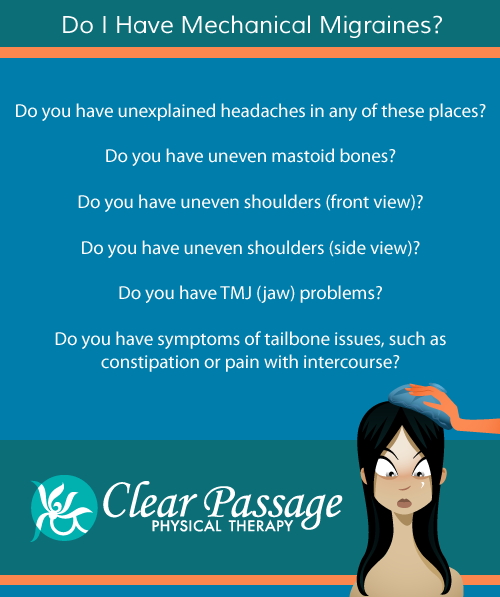
Migraine headaches can be caused by ‘mechanical’ factors, which are sometimes overlooked or left untreated by physicians. This type of headache typically does not respond to medication, sending patients on a frustrating journey from specialist to specialist as they search for a solution.
If you are seeking relief from migraine headaches, the first step is to find out whether they are caused by mechanical factors. Use the checklist below to determine if your headaches are mechanical. If so, our therapists can help you return to a pain-free life – without drugs – by decreasing mechanical and soft-tissue restrictions in your body.
Do you have unexplained headaches in any of these places?
- base of the skull, top of the neck
- anywhere along a line from your temples or eyes, or above either ear
- at the top of your head, sometimes along a top line from front to back
- at your TMJ muscles (at or below your ear), often accompanied by jaw popping or tooth grinding
Do you have uneven mastoid bones?
Stand in front of a mirror, feet comfortably separated. Place an index finger parallel to the floor at the bottom of each mastoid bone (just under your ear). Are your fingertips level with each other? If not, you may have uneven mastoids, which indicate a strong pull (usually in the side of the lower bone) that can cause recurring headaches.
Do you have uneven shoulders (front view)?
Relax with your feet stable, shoulder-width apart, and ask yourself:
- Are my shoulders the same height, or is one higher than the other?
- Do I carry my weight evenly on my two feet, or is one leg carrying more weight?
When the head’s support structures (shoulders or spine) are not aligned, it creates unusual pulls on the cranium, causing recurring headaches. When we correct asymmetries, first, in the support structures and then the head, we generally end the headaches.
Do you have uneven shoulders (side view)?
Standing upright in your normal posture, ask a friend to look at you from the side. Ask them to draw an imaginary line through the center of your ear, shoulder, and hip. The line should be vertical. The further forward your head, the more dramatic the pull on the back of your neck and head and up into your cranium, which can cause headaches at the base of the skull.

Do you have TMJ (jaw) problems?
Does my jaw click? Do I tend to grind my teeth or have other TMJ problems?
Jaw problems are generally secondary effects of asymmetries of the head/neck or cranial bones, which can create recurring headaches.
Do you have symptoms of tailbone issues, such as constipation or pain with intercourse?
Arising from events such as a fall onto your bottom or pelvic surgery, these symptoms indicate your tailbone may have been pushed or pulled forward, and healed in that position. A forward coccyx can create a pain-causing pull up the dura to attachments at the base of the skull and into the head.
If you answered yes in one or more categories, then you may have mechanical migraines. Request a free phone consultation with an expert therapist to learn more about how we can help you.
Related Content:
Chronic Pain
- Patient Story: Overcoming Chronic Pain After Multiple Traumas
- Adhesions: The Hidden Cause of Chronic Pain (Infographic)
- Post-surgical Pain and Adhesions
- Anti-Inflammatories and Reducing Inflammation Naturally
- Migraines/Chronic Headaches
- Do I Have Mechanical Migraines?
- Myofascial Pain
- How Does Clear Passage® Therapy Compare to Myofascial Release and Visceral Mobilization?
- Myofascial Pain Syndrome and Fibromyalgia: What Is the Difference?
- Sacroiliac Joint Pain



